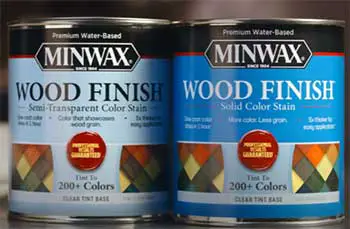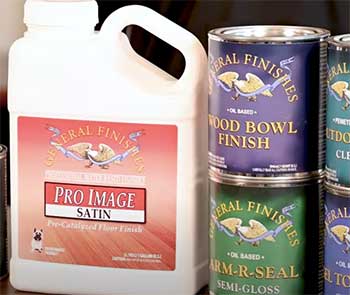If you’ve been anywhere near woodwork, you know how important staining is. Staining gives your wood products a nice finishing and acts as a barrier.
There are a lot of stain options like General Finish and Minwax. If you’re confused between them, here is a General Finishes vs. Minwax comparison to help you.
General finish and Minwax – both are top choices for woodworkers. Which one you’ll use is up to you, but here is a comparison of them to help you decide.
One-Minute Comparison Table
If you’re in a hurry or just want the gist of the entire comparison, this is for you. Here is a quick breakdown of the whole thing you can read in one minute. If you want a rush brief, just glance through it.
| Feature | General Finish | Minwax |
| Stain base | Water, oil, gel | Water, oil, gel |
| Ease of Application | Easy | Less easy |
| Application option | Brush, foam roller, cloth | Brush, foam roller |
| Coating consistency | Even | Less even |
| Coverage | Usually semi-transparent | Usually clear stain |
| Drying time | 0.5-24 hours | 2-6 hours |
With the basic rundown out of the way, let’s get into the detailed comparison of both brands now.
Detailed Comparison of General Finish And Minwax
As you can tell from the table above, this article will compare multiple features of both brands. The comparison will be more in-depth here so you can decide between them easily.
- Stain Base

Wood stains (and dyes) have different bases. Wood stains are a mix of coloring agents and “carriers”.
The color particles activate when the mix hits the wood.
Carriers are the solvents the color particles are mixed with.
These are what you know as the base.
A stain base is the first pointer to a wood stain’s overall performance. You can guess things like drying times if you know the base. The more popular stain bases are oil, gel, and water.
General Finish has been popular for its oil-based stains for a long time. Most of their woodwork product is oil-based and have a positive reputation.
They later added a water-based line for woodwork products (including stains). Recently they’ve introduced gel-based stains as well. Gel-based products aren’t a full line yet.
Minwax is the opposite. They’re more popular for their water and gel-based products. They have an oil-based woodwork product line but that rarely comes to the spotlight compared to the other two.
Either way, both brands have a range of water, gel, and oil-based stains.
- Ease of Application
The ease of application actually depends on multiple factors. The stain consistency, brush using liberty, and even adherence – these all determine ease of application.
General Finish has a foot forward in this department but Minwax isn’t too far behind.
Thicker wood stains are usually easier to apply on the surface. They seep through quickly (especially for porous wood) and are easy to control because of the consistency.
General Finish stains (all versions) are thicker than Minwax, so controlling them is easy. Even beginners can easily apply this.
- Application options
What brush you can use to apply your stain doesn’t really depend on the stain. Sometimes they work with even a rag, sometimes only specific brushes can do the job.
General Finish is more flexible when it comes to brushes. You can use a brush, foam roller, or even a rug to apply the stain.
Minwax is more restrictive on brushes, you can only use foam rollers or brushes to apply it properly.
- Coating consistency

Even adherence is something all woodworkers want. Since most stains need multiple coats, it is important the brush strokes aren’t standing out over a coat.
General Finish gets the edge here. The thick stain covers the surface easily. You won’t have to work much to cover the whole area, and the coat will be even.
Minwax is easy too, but sometimes the brush lines can stand out because of the lower consistency.
General Finish is much more beginner friendly than Minwax. If you’re looking for something you can easily control, you know which one you have to go for.
- Coverage
Coverage will tell you how much of the original wood texture you’ll be seeing. Solid coat stains completely cover the original wood surface like paint.
Semi-transparent stains are like translucent coatings, you can see the original stain but it is toned down. Clear stains don’t cover the original texture at all.
Most General Finish stains are semi-transparent. They cover the wood surface’s original texture but you can still see them peeking out. Since most of their products are oil based, they also show less grains.
Minwax stains are usually clear ones. They cover the wood like a tint and keep all the texture visible.
The only problem is that the grains on wood are more visible too, unless you’re going specifically for their oil-based stains.
- Drying time
Drying time depends on the stain base, but it can be different depending on the product too. Usually thick stains take more time to dry and thin stains dry quicker. Oil base stains take more time to dry compared to water based stains.
General Finish stains are like two extremes when it comes to drying time. The oil based thick stain takes almost 12-24 hours to dry before you can reapply another coat. The water based stain on the other hand takes about 0.5-2 hours to dry off.
Minwax stains have a more flexible drying time. The wood penetrating stain takes around 4-6 hours to dry off. The gel takes around 2 hours to dry off before you can apply a new coat.
- Price Considerations
When it comes to cost, General Finishes products fall into more of a premium, mid-range pricing tier while Minwax is very budget-friendly.
General Finishes stain prices range from $10-$20 for a quart. Topcoats like their High Performance Polyurethane cost around $25-$35 per quart.
Minwax stains are very affordable at around $7-$15 per quart. Their wipe-on polyurethanes cost just $15-$20 per quart.
For small DIY projects, opting for the cheaper Minwax products can save you quite a bit of money. But for larger high-end pieces where durability is key, the General Finishes premium products are worth the additional cost.
Pros and Cons Comparison
Here is a quick look at some of the main pros and cons for General Finishes and Minwax products:
General Finishes
Pros:
- Wide variety of unique stain colors
- Very durable, protective topcoats
- Easy no-drip application
- Quick dry time between coats
Cons:
- More expensive than Minwax
- Smaller selection of products overall
Minwax
Pros:
- Very budget-friendly pricing
- Huge selection of stains, oils, topcoats and finishes
- Good for casual projects
Cons:
- Oil-based poly topcoat not as protective
- More limited stain color options
- Longer dry times between coats
Which One Should You Choose?

If you’re more of a beginner or just want complete control over your wood stain, General Finish is the way to go. They’re also your option if you want a full coverage stain and don’t mind the long drying time.
If you have experience staining wood and your surface is vertical, go for the Minwax stains. They drip less so you can easily work with them for vertical surfaces.
They also dry quickly so you won’t have to wait the entire day before applying a new coat.
Frequently Asked Question (FAQ)
Well, that boils down to your personal preferences. All brands make a range of wood stains. The bases, drying time – everything is different. You’ll just have to figure out what you need. Whatever ticks off most boxes on your list is the best wood stain for you.
That depends on what you’re looking for. If you want full coverage or a thicker stain, oil based stains are the best for you. If you want something like a tint with a lower drying time, water based wood stains are the best.
Depends. If the surface you’re working with is raw wood then yes. You will need to sand between top coats. For best results, use a sanding sealer first. Then follow up with 2 coats of the top coat and sand between applications.
Again, it depends on your preferences. If you’re looking for less toxic options, water based stains are better than oil based ones. If you’re looking for durability and lasting period, oil based stains are better for you.
The main difference is that Minwax Polycrylic is a water-based polyurethane while General Finishes uses mostly oil-based, solvent-based finishes. General Finishes will provide better protection for heavy use surfaces.
Conclusion
When choosing between General Finishes and Minwax for your wood staining projects, consider the type of project, your skill level, and your budget.
For important high-end pieces where maximum protection is key, the premium durability and easy application of General Finishes makes it worth the extra cost.
For more casual projects, Minwax provides very affordable and approachable wood finishing options for DIYers.
Within each brand, make sure to choose the right combination of stain color and topcoat to achieve your desired look while keeping practical factors in mind. With some careful product selection, you can get beautiful, professional results from either General Finishes or Minwax.
